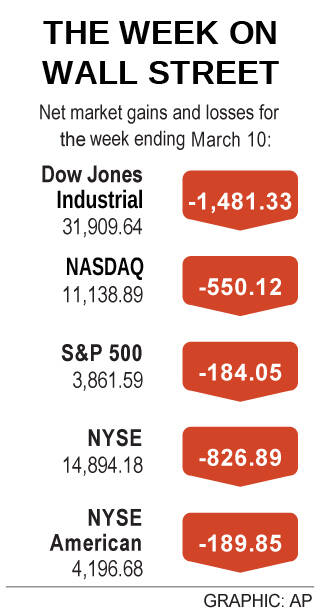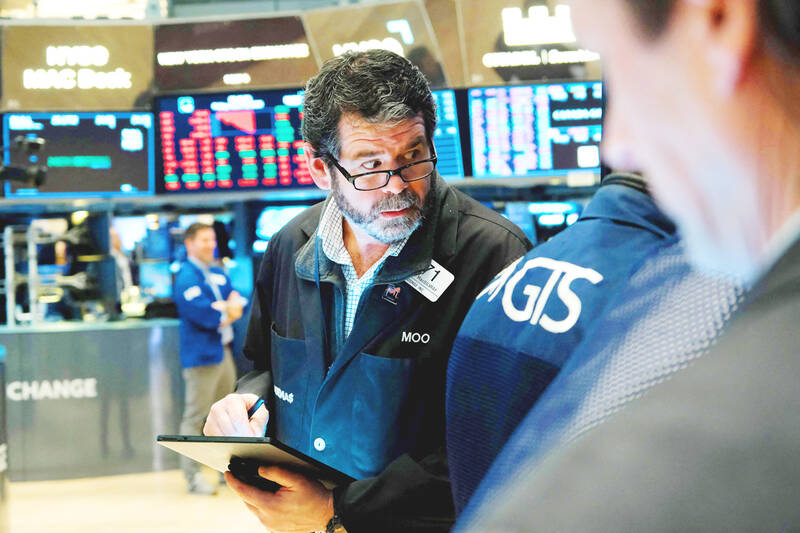Wall Street’s indices ended Friday down more than 1 percent as investors ran for the exits over fears for the health of US banks after the failure of a high-profile lender to the technology sector, overshadowing last month’s jobs report.
California banking regulators said they closed SVB Financial Group to protect deposits in what was the largest bank failure since the financial crisis. A capital crisis at SVB had already put pressure on bank stocks globally.
SVB had tried but failed to shore up its balance sheet through a stock sale proposed late on Wednesday.

The same day, crypto lender Silvergate Capital said it would have to wind down after huge losses from the FTX Trading Ltd cryptocurrency exchange collapse.
“There’s concern cracks may be appearing in the financial system as a result of the [US] Federal Reserve’s aggressive rate hikes,” said Carol Schleif, chief investment officer at BMO Family Office in Minneapolis. “The fear is whether it’s broader than one industry’s bank and one segment of the economy.”
While many investors looked through their bank holdings for signs of risk, Schleif said that much of the weakness in regional bank stocks stemmed from a “proverbial shoot-first-ask-questions-later situation.”

Photo: AFP
The KBW regional banking index ended the session down 2.4 percent, while the S&P 500 financials index lost 1.8 percent.
Schleif and other investors said they hoped regulations added to the US banking system since the 2008 financial crisis would prevent a similar catastrophe.
Yet still “people are very nervous because they don’t want a repeat,” she said.
The Dow Jones Industrial Average fell 345.22 points, or 1.07 percent, to 31,909.64, the S&P 500 lost 56.73 points, or 1.45 percent, to 3,861.59 and the NASDAQ Composite dropped 199.47 points, or 1.76 percent, to 11,138.89.
All 11 S&P 500 industry sectors lost ground. Real estate, down 3.3 percent, led declines, while consumer staples, the top performer, fell just 0.5 percent.
For the week, the S&P lost 4.55 percent in its biggest weekly percentage decline since September last year, but was clinging to a tiny year-to-date gain of 0.6 percent. The Dow fell 4.44 percent for the week and was down more than 3 percent for the year-to-date, while the NASDAQ declined 4.71 percent this week, but was up more than 6 percent so far this year.
The Cboe Volatility Index, an options-based indicator that reflects demand for protection against stock market declines, closed at a three-month high, up 2.19 points at 24.9, after touching a roughly five-month high during the session.
Investors had expected to end the week with most of their focus on economic data rather than banks.
Before the market opened, the closely monitored non-farm payrolls report showed that the US economy had added more jobs than expected last month, while average hourly earnings rose at a slower 0.2 percent versus 0.3 percent in January and unemployment rose to 3.6 percent.
The data had eased some concerns that the Fed could raise rates by 50 basis points at its meeting this month, after hawkish remarks from Fed Chairman Jerome Powell this week.
However, investors were more focused on uncertainties around the bank system, said John Praveen, managing director and cochief information officer at Paleo Leon in Princeton, New Jersey.
“Whatever positive vibes came out of the labor market report were upstaged by negative vibes from the SVB situation,” Praveen said.
Declining issues outnumbered advancing ones on the NYSE by a 4.75-to-1 ratio; on the NASDAQ, a 4.31-to-1 ratio favored decliners.
The S&P 500 posted no new 52-week highs and 40 new lows, while the NASDAQ Composite recorded 25 new highs and 493 new lows.
On US exchanges 15.17 billion shares changed hands, well above the 11.13 billion average for the past 20 sessions.

SEEKING CLARITY: Washington should not adopt measures that create uncertainties for ‘existing semiconductor investments,’ TSMC said referring to its US$165 billion in the US Taiwan Semiconductor Manufacturing Co (TSMC, 台積電) told the US that any future tariffs on Taiwanese semiconductors could reduce demand for chips and derail its pledge to increase its investment in Arizona. “New import restrictions could jeopardize current US leadership in the competitive technology industry and create uncertainties for many committed semiconductor capital projects in the US, including TSMC Arizona’s significant investment plan in Phoenix,” the chipmaker wrote in a letter to the US Department of Commerce. TSMC issued the warning in response to a solicitation for comments by the department on a possible tariff on semiconductor imports by US President Donald Trump’s

The government has launched a three-pronged strategy to attract local and international talent, aiming to position Taiwan as a new global hub following Nvidia Corp’s announcement that it has chosen Taipei as the site of its Taiwan headquarters. Nvidia cofounder and CEO Jensen Huang (黃仁勳) on Monday last week announced during his keynote speech at the Computex trade show in Taipei that the Nvidia Constellation, the company’s planned Taiwan headquarters, would be located in the Beitou-Shilin Technology Park (北投士林科技園區) in Taipei. Huang’s decision to establish a base in Taiwan is “primarily due to Taiwan’s talent pool and its strength in the semiconductor

Industrial production expanded 22.31 percent annually last month to 107.51, as increases in demand for high-performance computing (HPC) and artificial intelligence (AI) applications drove demand for locally-made chips and components. The manufacturing production index climbed 23.68 percent year-on-year to 108.37, marking the 14th consecutive month of increase, the Ministry of Economic Affairs said. In the first four months of this year, industrial and manufacturing production indices expanded 14.31 percent and 15.22 percent year-on-year, ministry data showed. The growth momentum is to extend into this month, with the manufacturing production index expected to rise between 11 percent and 15.1 percent annually, Department of Statistics

An earnings report from semiconductor giant and artificial intelligence (AI) bellwether Nvidia Corp takes center stage for Wall Street this week, as stocks hit a speed bump of worries over US federal deficits driving up Treasury yields. US equities pulled back last week after a torrid rally, as investors turned their attention to tax and spending legislation poised to swell the US government’s US$36 trillion in debt. Long-dated US Treasury yields rose amid the fiscal worries, with the 30-year yield topping 5 percent and hitting its highest level since late 2023. Stocks were dealt another blow on Friday when US President Donald